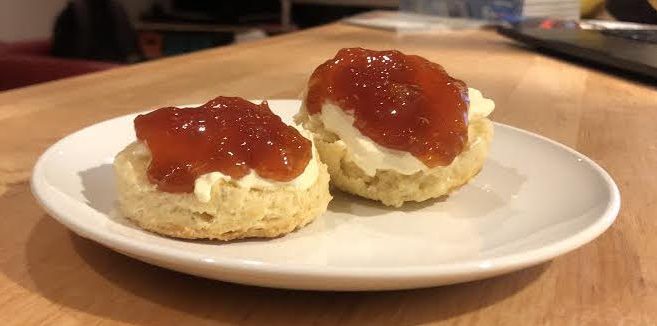Simple Scones, Two Ways (Plus Toppings!)
Serve these British scones with dollops of cream and jam.
March 29, 2019
On weekend mornings, all I want is something warm, rich, and easy to make. Both of these scone recipes are just that. British-style scones are less sweet and less rich, so that they can be spread with generous amounts of jam and cream later on. Their American counterparts are sweet, buttery, and endlessly customizable. When adding mix-ins, think chocolate chips, raspberries, chopped nuts, dried fruit, etc.
British Scones
Ingredients:
4 cups (500g) all-purpose or cake flour
2 tbsp baking powder
2 tbsp sugar
1 tsp salt
1 stick (½ cup) cold butter, diced
1 ⅓ cups (300 mL) milk
1 egg, beaten
Directions:
Preheat oven to 375ºF and line a baking sheet with parchment paper. Pulse flour, baking powder, sugar, and salt in a food processor. Add in the butter, then pulse until the mixture resembles breadcrumbs with no large clumps of butter remaining. Alternatively, whisk dry ingredients, then use your hands to mix in butter.
Next, pour in the milk, using a wooden spoon or a fork to incorporate to make a rough dough. Turn this out onto a clean, floured counter and lightly knead to bring together.
Roll out the dough to a thickness of 1 ½ inches. With a 2-3 inch biscuit cutter or the rim of a cup, cut out scones, making sure to release not by twisting, but by giving the scone a light shake back and forth.
Place scones on baking sheet and brush with egg wash. Bake for 17-22 minutes or until golden brown and fluffy. Enjoy warm with jam and clotted cream.
American Scones
Ingredients:
2 cups all-purpose flour
2 tbsp sugar
1 tbsp baking powder
1 tsp salt
5 tbsp cold unsalted butter, diced
½ cup mix-ins
1 cup heavy cream
Directions:
Preheat oven to 425ºF and line a baking sheet with parchment paper. In a food processor, pulse flour, sugar, baking powder, and salt to combine. Scatter pieces of butter over top, and pulse until the mixture resembles a coarse meal with pea-sized clumps of butter remaining.
Transfer the flour and butter mixture to a medium mixing bowl, and then stir in any additional ingredients. Pour in the cream and use a wooden spoon or your hand to stir it in until a rough dough forms. Tip this out onto a floured surface and shape into a circle. With a sharp knife, cut the circle into 8 wedges, then place on sheet. Bake for 12-15 minutes, or until golden brown on top.
Clotted Cream
No good scone is complete without a dollop of clotted cream—which resembles a hybrid of butter and whipped cream and tastes much better than it sounds.
Ingredients:
1 pint heavy cream, just “pasteurized” and not “ultrapasteurized”
Directions:
Preheat oven to 175ºF. Pour cream into a medium-sized glass baking dish. It should come an inch or two up the sides. Then, place cream into the oven and leave it for 12 hours (this works best overnight). Once done, remove cream and let cool to room temperature before placing in the fridge for at least 6 more hours.
Remove chilled cream from fridge and scrape the thicker solids (that’s the clotted cream!) from the liquid below. The liquid can be used in place of milk in any recipe. There should be a golden crust on top: it’s best to leave this on the cream but not mix it in so that you can enjoy its texture on its own. Place cream in a jar or other airtight container, it will keep refrigerated for a week.
Rhubarb Jam
This is an easy way to make jam that requires no real canning; it will store fine in the fridge for a week or two. Strawberry jam on scones is classic, but I love rhubarb for its tartness and color, and it is now in season.
Ingredients:
1 pound (about 6-7 stalks) rhubarb, chopped in 1-inch pieces
1 cup sugar
⅓ cup water
2 tbsp lemon juice
Seeds from ¼ lemon (around 5-6 seeds)
Salt
Directions:
Place a small plate in the freezer. Place rhubarb in a small saucepan with sugar, water, lemon juice, and lemon seeds.
Let mixture sit for an hour for the rhubarb to release any juices.
Then, bring to a boil over medium-high heat, stirring constantly to prevent burning. Continue to cook, still stirring, for 10 minutes.
Reduce heat to medium and continue to stir as the jam thickens. This will probably take somewhere between 10 and 20 minutes.
To test if it is done, place a small amount on the cold plate, spread it around a bit, then scrape it back together. If it looks thick, you’re all set. If it is still runny, continue to cook and test again in a few minutes.
When done, remove from heat and taste. Add in more lemon juice and a pinch of salt.
Store the jam in jars or a similar airtight container in the fridge.
This piece also appears in our March 2019 print edition.









